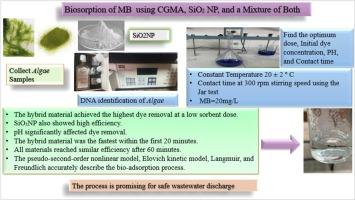Biosorption of methylene blue from industrial wastewater using silicon dioxide nanoparticles and Cladophora glomerata
IF 6.8
2区 工程技术
Q1 ENGINEERING, MULTIDISCIPLINARY
引用次数: 0
Abstract
Methylene Blue is a common pollutant in industrial wastewater, posing environmental risks, impacting aquatic ecosystems, and degrading the aesthetic quality of water. Biosorption has emerged as an effective alternative for wastewater treatment, utilizing various absorbents, including algae, for the removal of dyes. This study investigates the biosorption efficiency of Methylene Blue using Cladophora glomerata macroalgae and silicon dioxide nanoparticles, which were characterized using SEM and FTIR. Key parameters, including adsorbent dosage, pH, and contact time, were evaluated to optimize the removal process. Under optimal conditions (temperature: 20 ± 2 °C, stirring speed: 300 rpm, contact time: 60 min, pH: 5, initial dye concentration: 20 mg/L, and adsorbent dose: 1.3 g/L), silicon dioxide nanoparticles demonstrated nearly 100 % dye removal. Cladophora glomerata achieved 95.55 % removal within 50 min at a dosage of 1.0 g/L. A hybrid approach combining both adsorbents reached similar removal efficiency in 50 min at a lower dose of 0.6 g/L. Kinetic analysis revealed that the biosorption process followed the pseudo-second-order non-linear model, exhibiting high correlation coefficients (average R² = 0.996, 0.997, and 0.999). The biosorption data were well described by the Elovich kinetic model (R² > 0.9) and fitted both the Langmuir and the Freundlich isotherms, indicating a good fit of the experimental data, confirming monolayer adsorption on heterogeneous surfaces. These findings suggest that Cladophora glomerata, a macroalga, and silicon dioxide nanoparticles are efficient, cost-effective, and environmentally friendly adsorbents for removing Methylene Blue from industrial wastewater.

二氧化硅纳米颗粒和球藻对工业废水中亚甲基蓝的生物吸附
亚甲基蓝是工业废水中常见的污染物,对环境构成威胁,影响水生生态系统,降低水的审美质量。生物吸附已成为废水处理的有效替代方法,利用各种吸收剂,包括藻类,去除染料。利用扫描电镜(SEM)和傅里叶变换红外光谱(FTIR)对二氧化硅纳米粒子对亚甲基蓝的吸附效果进行了研究。对吸附剂投加量、pH、接触时间等关键参数进行了评价,以优化去除工艺。在最佳条件下(温度:20±2℃,搅拌速度:300 rpm,接触时间:60 min, pH: 5,初始染料浓度:20 mg/L,吸附剂剂量:1.3 g/L),二氧化硅纳米颗粒的去除率接近100% %。在1.0 g/L的剂量下,在50 min内对球藻的去除率达到95.55 %。结合两种吸附剂的混合方法在较低的0.6 g/L剂量下,在50 min内达到相似的去除效率。动力学分析表明,生物吸附过程符合拟二阶非线性模型,相关系数高(平均R²= 0.996、0.997和0.999)。Elovich动力学模型(R²> 0.9)很好地描述了生物吸附数据,并拟合Langmuir和Freundlich等温线,表明实验数据拟合良好,证实了在非均质表面上的单层吸附。这些发现表明,大藻Cladophora glomerata和二氧化硅纳米颗粒是一种高效、经济、环保的吸附剂,可用于去除工业废水中的亚甲基蓝。
本文章由计算机程序翻译,如有差异,请以英文原文为准。
求助全文
约1分钟内获得全文
求助全文
来源期刊

alexandria engineering journal
Engineering-General Engineering
CiteScore
11.20
自引率
4.40%
发文量
1015
审稿时长
43 days
期刊介绍:
Alexandria Engineering Journal is an international journal devoted to publishing high quality papers in the field of engineering and applied science. Alexandria Engineering Journal is cited in the Engineering Information Services (EIS) and the Chemical Abstracts (CA). The papers published in Alexandria Engineering Journal are grouped into five sections, according to the following classification:
• Mechanical, Production, Marine and Textile Engineering
• Electrical Engineering, Computer Science and Nuclear Engineering
• Civil and Architecture Engineering
• Chemical Engineering and Applied Sciences
• Environmental Engineering
 求助内容:
求助内容: 应助结果提醒方式:
应助结果提醒方式:


